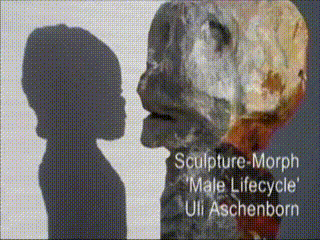Work
The Namibian media branded Uli Aschenborn's new style Amazing Changing Art, [5] [3] [6] [7] [8] [4] [9] because his new creations change – be it by themselves (video b) or because the viewer changes his position - or the painting is moved (videos a, c - i). For his chameleon-paintings, [5] [3] [6] [9] which change color and content if the angle of view is changed, he only needs sand and paint on his canvas. [3] The changing shadow of Aschenborn's turning sculptures [5] [10] show metamorphoses, e.g. the aging of a boy to an old man eventually to a skeleton (video b). The images within his Morph-Cubes (video i) distort in a grotesque way while the onlooker moves. [5] [10] [11] [12] Because movement is an integral part of these art works they are Kinetic Art.
Uli's paintings are inspired by not only his roots in Namibia, but by European liveliness complemented by landscapes (video e and photo k) [13] - also by abstract art. [14] [12]
The “Ensad Alumni Paris”, of the “l'Association des anciens élèves de l'École nationale supérieure des arts décoratifs” (i. e. the Alumni Association of the National School of Decorative Arts in Paris) has appointed Uli Aschenborn honorary member in 2018. [15] [16] [17]
This page is based on this
Wikipedia article Text is available under the
CC BY-SA 4.0 license; additional terms may apply.
Images, videos and audio are available under their respective licenses.





